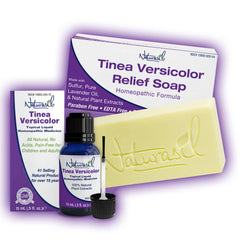Aunque las diferentes formas de tiña están relacionadas, cada una se presenta de forma ligeramente diferente, lo que a veces puede causar confusión a la hora de identificar la causa de la afección y, así, permitir un tratamiento eficiente y adecuado.
Tiña corporal
Quizás una de las formas más conocidas de tiña es tiña corporalTambién conocida como tiña corporal. Cuando se presenta en el cuerpo (generalmente en el torso, los brazos o las piernas), la tiña se presenta como una erupción roja, circular y escamosa que a menudo tiene un centro de color "normal". En personas de piel más oscura, la erupción también puede ser morada, gris o marrón.
La tiña corporal puede presentarse como un solo anillo o varios; además, puede ser incómoda y causar mucha picazón. La forma particular de la erupción es de donde proviene el nombre "tiña": tiene forma de anillo, pero no hay gusanos involucrados. Esta afección es causada por una infección fúngica altamente contagiosa.
Tiña crural
Al igual que la tiña corporal, tiña crural (una afección más comúnmente conocida como tiña inguinal) se presenta como una serie de manchas rojas y circulares que forman una erupción en los glúteos, la parte interna de los muslos o la ingle. La piel puede volver a estar enrojecida, con picazón, descamada y afectada por zonas de pérdida de cabello.
Tiña de la cabeza
Similarmente, tiña de la cabeza (o tiña del cuero cabelludo) se identifica por la característica erupción roja o las manchas con picazón y descamación. Debido a los cambios en la piel causados por los dermatofitos, causantes de la infección fúngica, el síntoma más común de la tiña de la cabeza es la caída irregular del cabello, acompañada de enrojecimiento, descamación y picazón.
Tiña versicolor
La tiña versicolor se ve bastante diferente de otros tipos de tiña que afectan la piel, y esto se debe a que esta es causada por un tipo diferente de hongo. En lugar de los dermatofitos que causan la tiña y la tiña inguinal, tiña versicolor Es causada por el crecimiento excesivo de un tipo de levadura que vive naturalmente en el cuerpo.
Si bien la descamación de la piel y la picazón a veces también pueden ser síntomas de la tiña versicolor, la principal diferencia estética radica en el tipo de erupción que presenta esta afección. La tiña versicolor suele presentarse como manchas de decoloración en la piel; estas manchas pueden ser rojas, rosadas o marrón pálido en pieles más claras. En pieles más oscuras, la decoloración puede ser más pálida que la piel circundante.
Generalmente, la tiña versicolor afecta el torso, el cuello, la parte superior de la espalda y la parte superior de los brazos. Puede cubrir áreas extensas o presentarse como pequeñas manchas. A diferencia del resto de la piel, las manchas de decoloración causadas por la tiña versicolor no se broncean con el sol.
Tiña del pie
También conocido como pie de atletaLa tiña del pie presenta varios síntomas estéticos característicos, como picazón y, en ocasiones, sangrado. Esta infección fúngica, que a menudo se presenta como manchas blancas y escamosas entre los dedos, también puede afectar la planta de los pies. En ocasiones, la piel se enrojece y se ampolla, y en casos más raros, la tiña del pie puede causar ampollas en los pies, tanto entre los dedos como en la planta.
Tiña ungueal
Tiña ungueal (también conocida como onicomicosis u hongos en las uñas de los pies) es otra infección fúngica que afecta las uñas de los pies. En casos raros, puede ser el resultado de un caso grave de tiña del pie. Los dermatofitos que infectan la uña del pie, a menudo a través de daños en la misma, generalmente causan un cambio en el color de la uña, incluyendo blanqueamiento, amarilleo o coloración amarillenta. Además, quienes padecen hongos en las uñas de los pies pueden notar que las uñas se rompen, se engrosan o se deforman, y pueden tener un aspecto turbio. En casos raros, la uña del pie puede desmoronarse o ennegrecerse.






